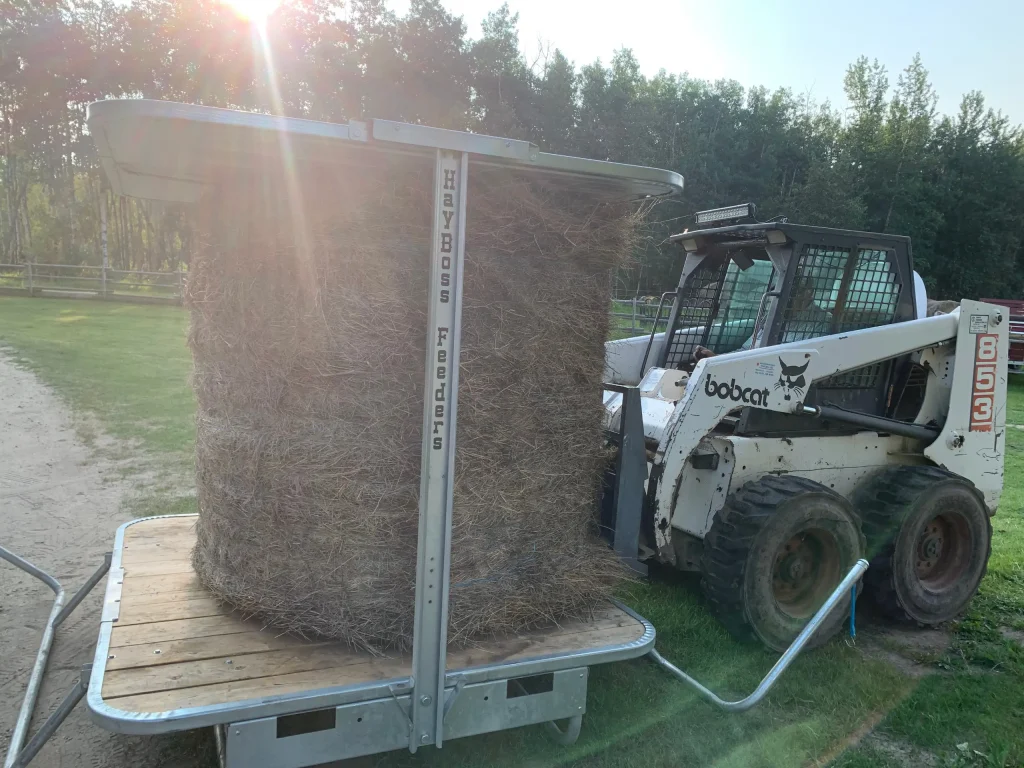Financing on Feeders also now available! Payments less than the amount of money you’ll save on Hay Costs!
Ever walk out to your pasture and find half your hay scattered like confetti? Feels quite frustrating, right?
Let’s face it, wasted hay is money down the drain. Scattered hay means unhappy animals and a lighter wallet for you. Hay feeders can be a solution to this problem!

Selecting the perfect hay feeder can be a game-changer! It will help you reduce waste, promote animal health, and save you time and money in the long run.
Our guide dives into 7 key factors to consider when choosing a hay feeder, helping you find the one that’s just right for your farm.
Hay feeders are more than just fancy troughs. They’re an investment in your animals’ well-being and your farm’s success. Here’s why they matter:
● Reduced Waste: Hay feeders minimize hay waste, putting more nutrients into your animals and less money down the drain.
● Improved Animal Health: Hay feeders promote controlled feeding, reducing the risk of digestive issues that can occur with unrestricted hay access. Happy and healthy animals mean a happy and productive farm!
● Cleaner Paddocks: Hay feeders keep hay off the ground, reducing mud contamination and the spread of bacteria. This translates to a cleaner environment for your animals and less muck for you to clean up.
Now that you’re confident about the power of feeders, let’s dive into the exciting world of choosing the right one for your farm. We’ve got a hay-stack of options to consider:
Horses munch on hay differently than cows, right? The feeder design should match your hay type (round bales, flakes, etc.) and your animal’s feeding style. For instance, round bale feeders with slow-feed nets are perfect for horses, while square bale feeders work well for cattle and other ruminants. If you are net feeding cattle it is better to go with a net with larger holes.
Ask yourself: What kind of animals do you raise? How do they typically eat hay? (Think about those messy eaters who might need a feeder that reduces the wastage of hay!)
Imagine that perfect bowl of cereal – not too big, not too small! Similarly, feeder size matters. Consider your herd size and feeding frequency. There are feeder options available in a range of sizes to accommodate any farm, from small hobby farms to large-scale operations. There is also something to consider when you have 2 different paddocks with different animals, having a feeder that could feed two different paddocks at once really makes for an efficient process.
Pro-Tip: Don’t forget to factor in growth! If you have young animals, you might want to choose a feeder with a little extra room to accommodate their future needs. XL-size feeder for large square bales would be a great choice but if you only have round bales then it would be the HayBoss Standard Feeder to expand your farm!

Here in North America, our weather can get wild. You need a feeder that can handle rain, snow, and everything in between. You need special feeders that are crafted from galvanized steel, built to withstand the elements and rough animals for years to come.
(Keep in note: Cheaply-made feeders can rust quickly, leaving you with a replacement project and more money down the drain. Invest in a quality feeder that will last!)
Safety Features
Safety first, always! Look for feeders that minimize the risk of injury to both you and your animals. Always look for feeders that are designed with smooth edges and thoughtful features to keep everyone safe and happy.
Pro-Tip: With covered feeders, this is a great way to help prevent rain, snow, or debris from contaminating the hay.
Can you think of any safety features that could be essential for your farm? (For example, if you have young animals, a feeder with a secure latch can help prevent accidental access.)
Minimizing Waste
Hay isn’t cheap, friends! Hay feeders are designed to fight waste with features like slow-feed nets that allow animals to nibble at their own pace, reducing hay mess and spoilage.
Pro-Tip: Hay feeders with slow-feed nets can also promote better digestion and reduce the risk of colic in horses.
Nobody wants a chore that takes forever. Perfect hay feeders should have strong built quality for easy use and maintenance. Some Feeders are designed for quick and easy loading of small square bales, while others, like DIY feeder kits, offer the option to build your feeder and save even more time and money.
(Consider feeders with easy-to-open latches, removable nets for cleaning the base, and being on skids, you chain up can drag the feeder around your property for convenience and promote grazing in different spots in the pasture. This also helps to supplement the feed so other parts of your property will have the time allotted for the grass to grow back.)
It is necessary to find the ideal balance between features and price. That is why you should look for a company that offers a variety of options to suit your budget, from budget-friendly small or large DIY feeders to top-of-the-line feeders loaded with features.
Remember, a quality hay feeder is an asset that pays off in the long run through reduced hay waste and a healthier herd.
Pro-Tip: Don’t be afraid to shop around and compare features before you buy.
Investing in a quality hay feeder isn’t just about saving money on hay – it’s about creating a win-win situation for you and your animals. Hay feeders promote better health, reduce waste, and save you time on chores.
So, it’s time for you to ditch the hay waste and say hello to happy animals and a thriving farm! HayBoss Feeders can help you get there. Contact us today and let’s discuss the perfect feeder for your needs!
HayBoss Feeders – Feed Smart